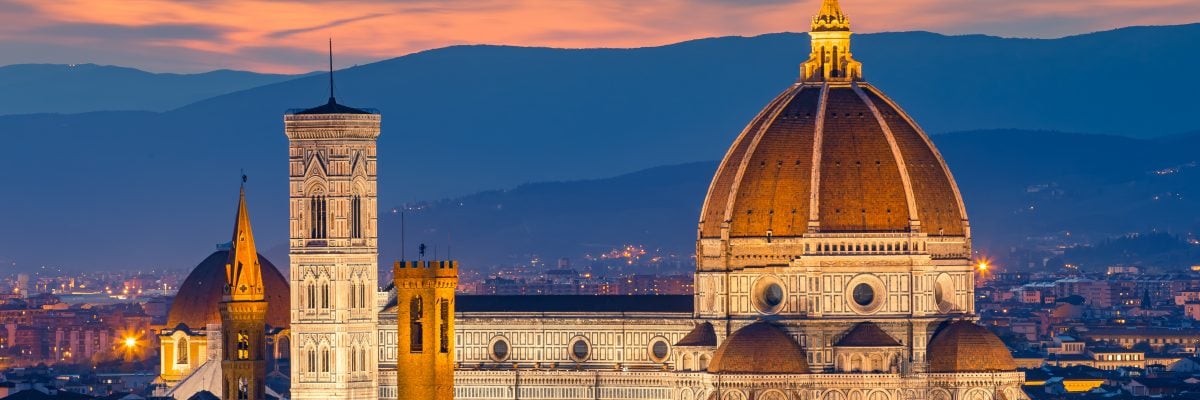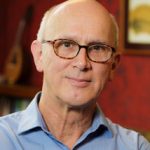
The top floor of Giotto’s campanile—just a few feet below the very peak—is 414 ever-narrowing steps above the pavement. That puts you almost at eye level with tourists who stand at the base of the lantern that sits atop Filippo Brunelleschi’s dome, the crowning symbol of Florence and, perhaps, of the entire Renaissance.
A light mist fell today as I looked the length of the duomo and at that magnificent, octagonal, and still-not-quite-finished dome. I imagined the double faith the Florentines had in constructing a new cathedral over the one that had served them for centuries. They not only had faith in their religion, which they wished to glorify along with their city, but faith that someone would come up with a way to construct a dome wider than any that had built before, without having to use extensive scaffolding. (There wasn’t enough timber in Tuscany to build such scaffolding anyway.)
Brunelleschi had studied ancient Roman buildings, and he learned something from the Pantheon. He realized he could construct dual domes, an inner and an outer, and could raise them simultaneously if he laid bricks in herringbone patterns that would be self-supporting. He devised cranes and other equipment that could project from the walls of the drum and then from the domes themselves, and with these devices he was able to lift four million bricks and other materials.
The interior of Santa Maria del Fiore (Saint Mary of the Flowers) is unremarkable. It looks stripped because it has been stripped. Over the centuries artworks have come and gone. Some have disappeared. Some are preserved only in fragments. Many are entire. Nearly all of the existent artworks are kept in the recently renovated Museo dell’Opera del Duomo, which is now twice the size it used to be. I intended to visit the museum today but discovered that it now is closed on the first Tuesday of every month. I’ll go tomorrow instead.
The director of the museum is an American priest, Msgr. Timothy Verdon. He has been in Florence nearly half a century, and I suppose it’s fair to call him the city’s top art historian, though he might disclaim the title. I had been hoping to meet with him but wasn’t able to make contact before leaving San Diego. Maybe I’ll luck out tomorrow and run into him. I want to ask him about the prize object in the cathedral’s treasury, a reliquary known as the “Small Book.” In a thriller (I’m giving some thought to writing one) it would make a fine MacGuffin, to use Alfred Hitchcock’s term.
I got here a few days ago, after having spent a week in Rome, where I participated in a symposium co-sponsored by the Emmanuel Community and the Pontifical Redemptor Hominis Institute. The theme was mercy. My talk was “Apologetics and Mercy,” two words that seldom appear in the same sentence. Among the other speakers were Philippe Barbarin, the cardinal archbishop of Lyon, and Cardinal Robert Sarah, the prefect of the Congregation for Divine Worship.
I recently had finished reading the latter’s God or Nothing, which I’ll write more about soon. When I was introduced to him, I said something that demonstrated that I had read the book. Smiling, I asked whether, when celebrating Mass, the cardinal sometimes still comes across a snake at the credence table. He laughed and held my hand all the more firmly.
I should explain. Sarah is from Guinea, the only child of parents who were converts. Once, when he was serving as an altar boy, he turned to get the cruets and found a snake on the credence table. He didn’t let that stop him. After Mass, the priest praised him for his courage. In later years, as a priest and bishop, Sarah needed courage and more, as he led his flock under a brutal dictatorship.
There was another prelate at the symposium, Dominique Rey, the bishop of Frejus-Toulon, a diocese along France’s coast, roughly between Marseilles and Nice. He has visited the Catholic Answers office twice, each time bringing with him several dozen priests, religious, and laymen. In terms of ordinations, he far and away is the most successful bishop in France, even though his diocese has only 700,000 Catholics. He has established or authorized something like fifty new apostolates, catering to every flavor of Catholic orthodoxy. It was a delight to see him again and a privilege to have been invited by him to speak at the symposium.
I got to Florence Sunday afternoon. There is no end to culinary delights, as there is no end to artistic delights. But by the time I returned to my lodgings this evening I was tired and so ate at the restaurant next door, Biancorosso, which serves both Italian and Japanese food. The owner is from the Osaka area. We had a fine talk as I waited for my miso soup, white rice, and Japanese-style chicken.



